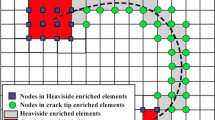The distribution of local stresses and strains in a specimen in the vicinity of the crack tip in 50G and 32G2 casing pipe steels with different microstructure is obtained by simulating the stress-strain state at the crack tip and using numerical calculations. Steels are distinguished by atypical mechanical behavior: lower-strength 50G steel with a coarse-grained ferrite-pearlite structure is characterized by lower resistance to brittle fracture compared to 32G2 steel with a fine-grained bainite structure. The finite element method is used to simulate the specimen with a crack, and for calculations the true stress-strain curves of the steels are used. The calculation results confirm a higher susceptibility of the coarsegrained steel to crack propagation by brittle fracture.


Similar content being viewed by others
References
R. J. Davies, S. Almond, R. S. Ward, R. B. Jackson, C. Adams, F. Worrall, L. G. Herringshaw, J. G. Gluyas, and M. A. Whitehead, “Oil and gas wells and their integrity: implications for shale and unconventional resource exploitation,” Mar. Pet. Geol., 56, 239–254 (2014); DOI: https://doi.org/10.1016/j.marpetgeo.2014.07.014.
A. I. Mohammed, B. Oyeneyin, B. Atchison, and J. Njuguna, “Casing structural integrity and failure modes in a range of well types: a review,” J. Nat. Gas Sci. Eng., 68, Article number: 102898 (2019); DOI: https://doi.org/10.1016/j.jngse.2019.05.011.
M. S. Khoma, V. A. Vynar, B. M. Datsko, V. R. Ivashkiv, M. R. Chuchman, Yu. Ya. Maksishko, and R. L. Bukliv, “Corrosion and mechanical fracture of steels for casing pipes under the influence of elevated temperatures and pressure of carbon dioxide,” Mater. Sci., 57, No. 1, 194–100 (2021); DOI: https://doi.org/10.1007/s11003-021-00519-0.
O. I. Zvirko, O. T. Tsyrulnyk, I. Dzioba, N. V. Kret, and S. Lipiec, “Influence of the structural features of steels of casing pipes on their mechanical properties and hydrogen brittleness,” Mater. Sci., 56, No. 6, 48–754 (2021); DOI: https://doi.org/10.1007/s11003-021-00491-9.
O. Zvirko, O. Tsyrulnyk, S. Lipiec, and I. Dzioba, “Evaluation of corrosion, mechanical properties and hydrogen embrittlement of casing pipe steels with different microstructure,” Materials, 14, Is. 24, Article number: 7860 (2021); DOI: https://doi.org/10.3390/ma14247860.
D. A. López., T. Pérez., and S. N. Simison, “The influence of microstructure and chemical composition of carbon and low alloy steels in CO2 corrosion. A state-of the-art appraisal,” Mater. Des., 24, Is. 8, 561–575 (2003); DOI: https://doi.org/10.1016/S0261-3069(03)00158-4.
T. Xu, Y. Feng, S. Song, and Z. Jin, “Evaluation of mechanical properties and microstructures of casing-drilling steels,” Adv. Mater. Res., 146–147, 674–677 (2011); DOI: https://doi.org/10.4028/www.scientific.net/AMR.146-147.674.
T. Xu, Z. Jin, Y. Feng, S. Song, and D. Wang, “Study on the static and dynamic fracture mechanism of different casing-drilling steel grades,” Mater. Charact., 67, 1–9 (2012); DOI: https://doi.org/10.1016/j.matchar.2012.02.016.
R. Wang, and S. Luo, “Grooving corrosion of electric-resistance-welded oil well casing of J55 steel,” Corr. Sci., 68, 119–127 (2013); DOI: https://doi.org/10.1016/j.corsci.2012.11.002.
B. Li, M. Luo, Z. Yang, F. Yang, H. Liu, H. Tang, Z. Zhang, and J. Zhang, “Microstructure evolution of the semi-macro segregation induced banded structure in high strength oil tubes during quenching and tempering treatments,” Materials, 12, Is. 20, 1–3 (2019); DOI: https://doi.org/10.3390/ma12203310.
Q. Zhang, Q. Yuan, Z. Xiong, M. Liu, and G. Xu, “Effects of Q&T parameters on phase transformation, microstructure, precipitation and mechanical properties in an oil casing steel,” Phys. Met. Metallogr., 122, Is. 14, 1463–1472 (2021); DOI: https://doi.org/10.1134/S0031918X21140180.
E. W. J. Van Hunnik, B. F. M. Pots, and E. L. J. A. Hendriksen, “The formation of protective FeCO3 corrosion product layers in CO2 corrosion,” in: Proc. of the Int. Conf. Corrosion-96, NACE Int., 1996-March, Denver, Colorado, USA (1996).
E. I. Kryzhanivskyi, H. M. Nykyforchyn, O. Z. Student, H. V. Krechkovska, and I. I. Chudyk, “Role of nonmetallic inclusions in premature stress-corrosion fractures of drill pipes,” Mater. Sci., 55, No. 6, 822–830 (2020); DOI: https://doi.org/10.1007/s11003-020-00375-4.
I. Dzioba, O. Zvirko, and S. Lipiec, “Assessment of operational degradation of pipeline steel based on true stress–strain diagrams,” Lecture Notes in Civil Engineering, 102, 175–187 (2021); DOI: https://doi.org/10.1007/978-3-030-58073-5_14.
Y. Bao, and T. Wierzbicki, “On fracture locus in the equivalent strain and stress triaxiality space,” Int. J. Mech. Sci., 46, Is. 1, 81–98 (2004); DOI: https://doi.org/10.1016/j.ijmecsci.2004.02.006.
Y. Bao, and T. Wierzbicki, “A new model of metal plasticity and fracture with pressure and lode dependence,” Int. J. Plast., 24, Is. 6, 1071–1096 (2008); DOI: https://doi.org/10.1016/j.ijplas.2007.09.004.
A. Neimitz, J. Gałkiewicz, S. Lipiec, and I. Dzioba, “Estimation of the onset of crack growth in ductile materials,” Materials, 11, Is. 10, 1–19 (2018); DOI: https://doi.org/10.3390/ma11102026.
Z. T. Nazarchuk, and H. M. Nykyforchyn, “Structural and corrosion fracture mechanics as components of the physicochemical mechanics of materials,” Mater. Sci., 54, No. 1, 7–21 (2018); DOI: https://doi.org/10.1007/s11003-018-0151-x.
R. O. Ritchie., J. F. Knott., and J. R. Rice, “On the relationship between critical tensile stress and fracture toughness in mild steel,” J. Mech. Phys. Solids, 21, Is. 6, 395–410 (1973); DOI: https://doi.org/10.1016/0022-5096(73)90008-2.
A. Neimitz., M. Graba., and J. Gałkiewicz, “An alternative formulation of the Ritchie-Knott-Rice local fracture criterion,” Eng. Fract. Mech., 74, Is. 8, 1308–1322 (2007); DOI: https://doi.org/10.1016/j.engfracmech.2006.07.015.
Author information
Authors and Affiliations
Corresponding author
Additional information
Translated from Fizyko-Khimichna Mekhanika Materialiv, Vol. 58, No. 4, pp. 32–36, July–August, 2022
Rights and permissions
Springer Nature or its licensor (e.g. a society or other partner) holds exclusive rights to this article under a publishing agreement with the author(s) or other rightsholder(s); author self-archiving of the accepted manuscript version of this article is solely governed by the terms of such publishing agreement and applicable law.
About this article
Cite this article
Zvirko, O.I., Lipec, S., Vengreniuk, O.I. et al. Evaluation of the Stress-Strain State at the Crack Tip in Casing Pipes Based on Numerical Simulation. Mater Sci 58, 460–465 (2023). https://doi.org/10.1007/s11003-023-00685-3
Received:
Published:
Issue Date:
DOI: https://doi.org/10.1007/s11003-023-00685-3




